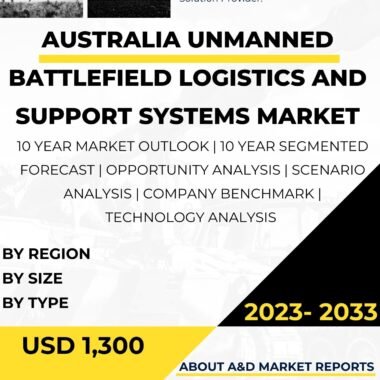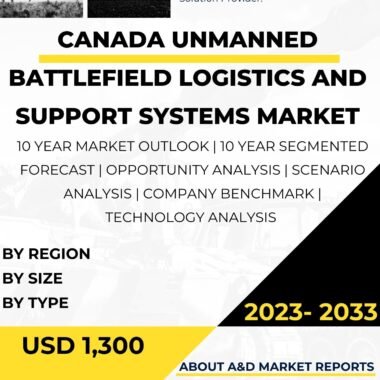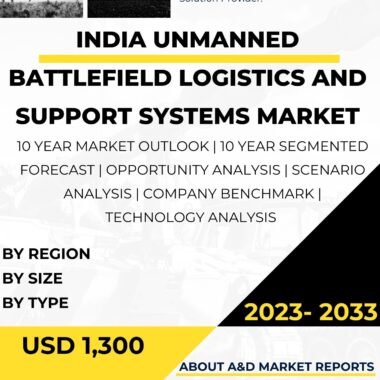Description
The Unmanned Battlefield Logistics and Support Systems market in Malaysia has witnessed significant growth and development in recent years, reflecting the country’s commitment to enhancing its military capabilities and adopting innovative technologies to support its armed forces. Unmanned battlefield logistics and support systems refer to a range of unmanned vehicles and technologies designed to provide critical logistics support and enhance operational efficiency on the battlefield. The adoption of state-of-the-art unmanned systems enables Malaysia to establish a modern and effective military logistics network, contributing to the country’s overall defense preparedness and operational effectiveness.
As a nation with strategic geopolitical importance in Southeast Asia, Malaysia faces diverse security challenges, including potential threats from hostile forces and the need to maintain a capable and agile military. The use of unmanned battlefield logistics and support systems allows Malaysia to improve its military logistics capabilities, ensure timely and efficient delivery of supplies and equipment to the frontline, and reduce the risks faced by personnel during hazardous operations.
The Unmanned Battlefield Logistics and Support Systems market in Malaysia has witnessed significant technological advancements. Modern unmanned systems include unmanned ground vehicles (UGVs), unmanned aerial vehicles (UAVs), unmanned underwater vehicles (UUVs), and autonomous supply chain technologies. These unmanned systems are equipped with advanced sensors, artificial intelligence, and communication capabilities, enabling them to operate in challenging battlefield environments and perform a wide range of logistics tasks.
Moreover, unmanned battlefield logistics and support systems play a pivotal role in the capabilities of the Malaysian Armed Forces. The Malaysian Army, Royal Malaysian Navy, and Royal Malaysian Air Force utilize unmanned systems to enhance their logistics and support capabilities. Unmanned systems are deployed for tasks such as transportation of supplies, medical evacuation, reconnaissance, surveillance, and intelligence gathering.
Additionally, the adoption of advanced unmanned battlefield logistics and support systems supports Malaysia’s commitment to enhancing its defense industrial base and fostering indigenous defense capabilities. The Malaysian government has shown interest in developing and manufacturing unmanned systems through local research and development (R&D) initiatives and partnerships with global defense companies.
The Malaysian government has recognized the importance of international collaborations in acquiring and developing unmanned system technologies. Partnerships with leading global defense contractors and unmanned system manufacturers have facilitated access to cutting-edge technologies and expertise. These collaborations have enabled technology transfer and capacity building, contributing to the growth of Malaysia’s domestic unmanned system capabilities.
While the Unmanned Battlefield Logistics and Support Systems market in Malaysia shows promise, it is not without challenges. One of the primary hurdles is the high cost of acquiring and maintaining advanced unmanned systems. These sophisticated technologies require significant investment in research, development, procurement, training, and logistical support. Budget constraints may impact the pace and scale of unmanned system acquisition and modernization efforts.
Moreover, ensuring skilled operators, maintenance personnel, and specialized training are essential for maximizing the benefits of unmanned systems. The Malaysian Armed Forces must invest in continuous training and education to ensure their personnel possess the necessary expertise to operate and maintain unmanned systems effectively and securely.
Additionally, addressing interoperability and integration challenges is crucial for successful unmanned system operations. Ensuring seamless coordination and communication between different branches of the armed forces and their respective unmanned systems is essential for joint operations and effective logistics support.
Looking ahead, the Unmanned Battlefield Logistics and Support Systems market in Malaysia is poised for further growth. The government’s commitment to enhancing its military capabilities, improving logistics support, and investing in advanced unmanned system technologies will drive continued investments in unmanned systems. As unmanned system technologies continue to evolve and demonstrate their effectiveness, they are likely to play an increasingly pivotal role in Malaysia’s defense and military logistics strategy.
Moreover, Malaysia’s participation in regional security collaborations and joint military exercises will likely influence its unmanned system requirements. As the country seeks to strengthen its position as a key player in regional defense and security cooperation, the demand for advanced unmanned systems with interoperability and compatibility with allied forces will increase.
In conclusion, the Unmanned Battlefield Logistics and Support Systems market in Malaysia has experienced significant growth and progress. The government’s focus on enhancing its military capabilities, improving logistics support, and investing in advanced unmanned system technologies has paved the way for the integration of modern unmanned systems. International collaborations and domestic research efforts have positioned Malaysia as a participant in the global unmanned system technology landscape.
However, challenges related to budget constraints, technology development, training, integration, unmanned system requirements, and engineering expertise must be addressed proactively to sustain and enhance the growth of the Unmanned Battlefield Logistics and Support Systems market in the years to come. By maintaining a modern and effective unmanned logistics and support capability, Malaysia can effectively enhance its defense preparedness, improve operational efficiency, and strengthen its overall military logistics capabilities.




